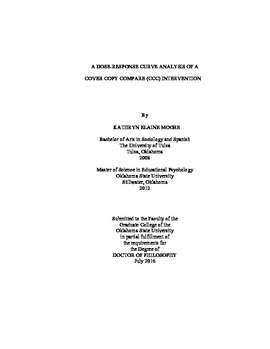| dc.contributor.advisor | Duhon, Gary J. | |
| dc.contributor.author | Moore, Kathryn Elaine | |
| dc.date.accessioned | 2017-02-22T22:10:13Z | |
| dc.date.available | 2017-02-22T22:10:13Z | |
| dc.date.issued | 2016-07 | |
| dc.identifier.uri | https://hdl.handle.net/11244/48849 | |
| dc.description.abstract | While various approaches to academic intervention intensification exist, it is important to determine which methods actually strengthen the intervention by producing improved student outcomes. Common conceptualizations of intervention intensification include modifications such as increasing components, staff resources, or time. However, research indicates that these forms of intensification do not always produce a greater effect. To increase our understanding of academic interventions and how to strengthen them, it is important that we examine how intensifications affect student response. In medicine, researchers regularly evaluate treatment intensity in terms of the dose administered and the associated patient response. Similar studies in education may permit more precise intervention recommendations. Few academic intervention studies have applied the concept of dose in order to quantify changes made to an intervention to measure effects on student response. The present study demonstrates that increasing the frequency, or dose, of an evidence-based academic intervention, Cover Copy Compare (CCC), can produce associated increases in student response. Increased frequency of the CCC intervention produced associated increases in student growth rates with no maximum effective dose reached. This information is valuable to school staff responsible for remediating student deficits, because it provides insight not only into intervention intensity but also intervention strength. These findings also suggest that it may be possible to predict student growth rates based on the intervention, their grade level, and the target skill. Additional research is needed to understand how increased frequency of other evidence-based academic interventions impact student learning rate. Continuing this line of research may allow practitioners to prescribe evidence-based academic interventions with more precision so that basic skills deficits can be more efficiently and effectively remediated within available timeframes. | |
| dc.format | application/pdf | |
| dc.language | en_US | |
| dc.rights | Copyright is held by the author who has granted the Oklahoma State University Library the non-exclusive right to share this material in its institutional repository. Contact Digital Library Services at lib-dls@okstate.edu or 405-744-9161 for the permission policy on the use, reproduction or distribution of this material. | |
| dc.title | Dose-response curve analysis of a Cover Copy Compare (CCC) intervention | |
| dc.contributor.committeeMember | Poncy, Brian C. | |
| dc.contributor.committeeMember | Solomon, Benjamin G. | |
| dc.contributor.committeeMember | Davis, C. Robert | |
| osu.filename | Moore_okstate_0664D_14587.pdf | |
| osu.accesstype | Open Access | |
| dc.type.genre | Dissertation | |
| dc.type.material | Text | |
| thesis.degree.discipline | Educational Psychology | |
| thesis.degree.grantor | Oklahoma State University | |
